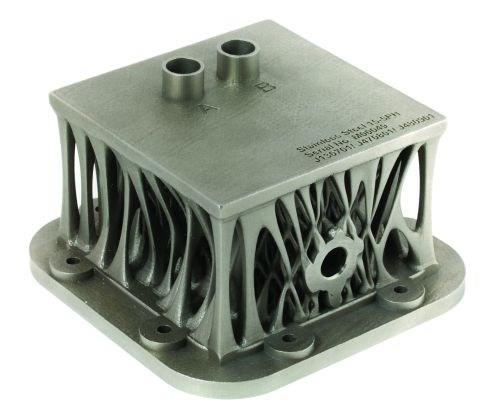Nature Triumphant
The freedom to tailor a part’s shape to its engineering needs—particularly when the result is a complex organic form—might be the most transformative benefit of additive manufacturing.
When I stand up, none of the leg bones that support my weight is a straight, solid shaft. Instead, a bone is curved, it has a varying cross section, and a close view of the bone reveals that the material is not solid but a porous lattice.
Compare that to a manufactured component. If a manufacturer produced a comparable structural member—say, a machine component that moves a weight upright—then this part most likely would be solid and straight. A form such as this is what our established manufacturing methods are suited to produce. Using those established methods to make a part as complex as a bone would be so expensive that we don’t think much about this option. We accept straight lines and high material density as two defining traits of engineered objects.
Yet this acceptance comes at a cost. Compared to that leg bone, the machine component is a poor performer. Its strength-to-weight ratio is lower, suggesting that the man-made part is heavier and costlier than it needs to be.
Enter additive manufacturing. Given an additive approach to production, complexity is cheap. An elaborate form can be 3D printed just as easily as a simple one. As a result, subtle curves and lattice structures become design options that are accessible and easy to employ.
The photo above illustrates what that promise might mean. The part seen here was designed using software from Within Technologies (a maker of tools for engineering complex forms) and produced through laser sintering on a machine from EOS. The part represents a simple component—a weight-bearing manifold—reimagined for additive production.
How would this same part be made traditionally? Likely it would begin as a solid block. Its channels would be drilled. Additive manufacturing opens the door to a dramatically different solution, one that is more efficient in multiple ways. Inside the part, the mating ducts curve together for better fluid flow than straight holes that intersect at a corner. In addition, this form that was designed specifically to bear the part’s intended load uses only the amount of material necessary for this purpose. That makes the part lighter than the solid block would be, and less wasteful of stock.
In other words, the more natural form is better. In light of this, our expectations about how man-made parts should look and feel might have to give way. Imagine how different our manufactured world might soon start to look, as engineers increasingly exercise the freedom to move away from straight shafts, square housings and solid supports in favor of more organic shapes.
Related Content
-
How to Supply Cooling to Additive Tooling
Additive tooling provides limitless options for cooling a mold’s difficult-to-cool areas.
-
How to Make Data Work for Mold Productivity and Performance
The use of digital workflows improves the impact of mold design libraries, conformal cooling and machine learning.
-
MMT Chats: 4 Keys to a Successful Mold-Building Operation: Innovation, Transparency, Accessibility and Relationship
MoldMaking Technology Editorial Director Christina Fuges chats with Steve Michon, co-owner of Zero Tolerance in Clinton Township, Michigan, about the excitement of solving problems, the benefits of showing gratitude, the real struggle with delegation and the importance of staying on top of technology. This episode is brought to you by ISCAR with New Ideas for Machining Intelligently.










.jpg;maxWidth=300;quality=90)




